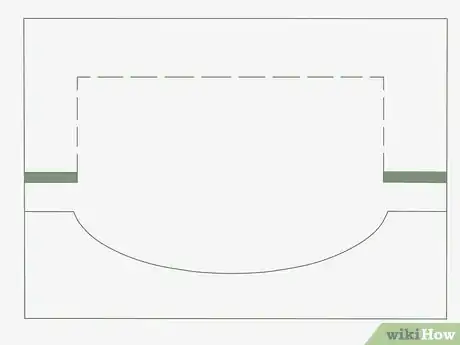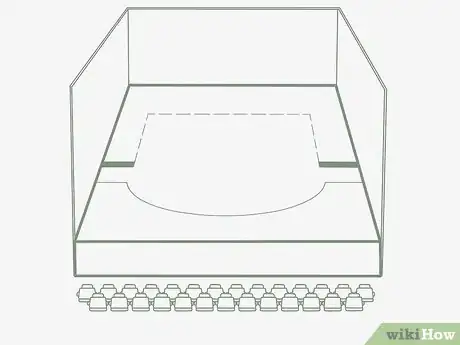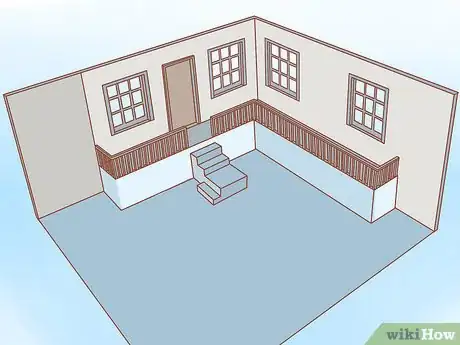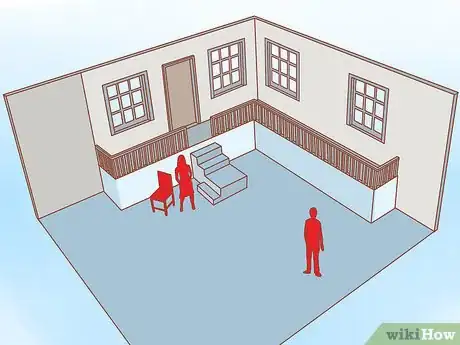This article was co-authored by wikiHow Staff. Our trained team of editors and researchers validate articles for accuracy and comprehensiveness. wikiHow's Content Management Team carefully monitors the work from our editorial staff to ensure that each article is backed by trusted research and meets our high quality standards.
This article has been viewed 70,872 times.
Learn more...
Designing an artistic, effective, and practical theatrical set poses many challenges. The good news is that although set designs differ greatly, there’re several basic principles you can follow for any play, opera, or other type of performance. Begin by reading the play and envisioning what stage set components the audience members need to see to bring the play to life. Also keep in mind budgetary restrictions and the level of production that you’re staging.
Steps
Getting to Know the Script
-
1Read the script and note any specific requirements about the set. Before you can begin to design your stage set, it’s important that you understand the details of the script and the staging requirements. Pay special attention to any scenes that require specific physical set pieces to be onstage for the actors to use. For example, certain parts of the script may require your set to have stairs or doors placed on stage. Or, there may be a dramatic scene around a family dinner table.[1]
- At this point, you can also note the mood of the play and common emotions that come up, and start thinking about how to match these emotions with the set design (e.g., with colors or textures).
- Even if the play or opera that you’re designing a set for is a famous piece of literature (e.g., Othello), still ask the director for a copy of the script. Directors often omit scenes or make changes to the stage directions, etc.
-
2Note the time period during which the production is set. These specifics will help you choose the proper furniture and decorations, since they’ll need to match the objects described in the script and will need to be appropriate to the time period. You can use contemporary furniture and set pieces for productions set during the 20th century. For earlier pieces, you may need specific antique inventory in order to accurately match the set time.
- Local antique or vintage shops can be a great resource for a budget production. Also check garage sales.
Advertisement -
3Identify the setting and scenery of the play or opera. Some plays and operas rely heavily on the stage decoration to communicate a sense of location, whether the majority of scenes take place indoors or outdoors. You can do this with place-specific stage items and by through using color and wall hangings to communicate place. For example, for a production set in Vermont, you’d want practical, wooden furniture, while for a piece set in Paris, a lavish and showy set would be more fitting.
- Keep in mind that these place and time-period details were included for a reason, so ensure that you lay out the set following the author’s intentions.
- Productions set in historical time periods require greater attention to detail and accuracy of the dressing’s timeliness.
-
4Figure out how many different set pieces you’ll need to construct. In many productions, the action takes place in different time periods or throughout various locations. Unless you’re staging a minimalist play, each of these different settings will need a distinct look. When you get around to building the actual sets themselves, try hammering together several large sheets of particle board or plywood, and then painting those to bring the backgrounds to life.[2]
- If there’s 1 section of the set background that will remain the same through all of the productions acts, you could hang the background with sheets of appropriately-colored butcher paper.
- For example, for a staging of Peter Pan, you could design a warm and whimsical-feeling interior scene for the children’s bedroom and a nautical-themed set backdrop for scenes on Captain Hook’s pirate ship.
-
5Discuss the overall look and feel with the director and costume designer. The director will likely have some thoughts on how the stage set should be designed and laid out. Also talk with the costume designer to see what aesthetic they plan to use, since this will influence your set design. If the director wants the production to have a warm aesthetic that will welcome the audience, plan to use warm yellow and blue colors and to set the stage with gentle gestures.[3]
- It’s especially important that the costumes and stage setting make use of the same color palette.
- For example, it would confuse the audience to see fancy, rich costumes on the characters in a performance of Romeo and Juliet next to a sparse stage setting.
Designing the Floor Set
-
1Plan a stage layout that fits in the space and lets actors move naturally. Depending on the location where the production is being staged, you may have a small or oddly-shaped stage to work with. Plan where to put the different physical objects that will be on the stage, from tables and chairs to balconies and ladders. For most plays, in order for the stage set to feel realistic and fleshed out, plan to situate 3-4 pieces of furniture around the stage, in addition to background elements like framed pictures, bookshelves, or a dresser.
- Leave at least 4–5 ft (1.2–1.5 m) between set pieces, since the actors will need to move through the set without bumping into furniture.
- Also have clear entrances and exits on both sides of the set (stage right and stage left) so actors won’t be confused about how they should walk on and off of the stage. This layout is often referred to as a “ground plan.”
- Work with the director to ensure that the actors will be able to move naturally between the set pieces.
-
2Sketch out a layout of the floor set with paper and pen. The typical stage set design needs a minimum of 3 walls, so consider beginning your layout with these. Then sketch in the other set pieces to give yourself—and the set builders—an idea of how everything will fit together.[4] Include any tables, chairs, stairways, or raised platforms that will be onstage. Make sure to include any door openings and windows within the walls.
- If you’re designing a large stage set, place the stage-right and stage-left walls at an angle that allows for maximum set area.
- Sketch where all movable pieces (like platforms and furniture) will be placed using an overhead perspective.
-
3Draw another sketch of the set from the audience’s perspective. The set is a crucial part of any performance and will be the first thing that audience members see. Sketch the set from the point of view of the auditorium to figure out the audience’s sightlines.[5] Make sure that none of the key focal points in a scene are blocked by other set pieces, and take advantage of the full space of the stage to spread out furniture and background pieces. Make adjustments to the set design as needed.
- For example, if you realize that a hanging chandelier will block actors speaking at the top of a staircase, move the planned location of the staircase.
- When making this sketch, don’t forget to include specifics like colors, wall hangings and lighting fixtures in your plan.
-
4Design the stage set to help bring scenes to life for the audience. The whole point of a successfully-designed stage setting is to make the audience feel as though they’re really in each scene. Compose the stage set design for each scene so that it focuses the audience’s attention on the major elements of the action. Also use background colors—like the colors of wall hangings and painted background set pieces—to convey a specific mood that you’d like the audience to feel during each scene.
- For example, in the famous balcony scene in Romeo and Juliet, compose the stage set with the balcony in the center so the audience will fully focus their attention on the dialogue.
- If a certain scene features the villain and should excite or scare the audience, the stage set should feature bold colors like red and yellow. For a calmer, mellower scene, use colors like blue, light green, or pale gray.
-
5Create a 1:25 scaled model of your set for a professional production. A scale model will help bring your stage set to light and will allow you to visualize the way that the stage will look when it's full size. A scaled model of stage set design can be constructed with particle board, cardboard, balsa wood, and model furniture. Ensure that your set is built to scale or you risk dealing with complications when the actual construction work begins.
- If you’re working on an amateur performance (e.g., a community theater production or high school performance), you can skip this step. In most cases, amateur stage sets won’t be complex enough to justify making a model.
Dressing the Set
-
1Design hangings, draperies, and other items for the set walls. Stage set design isn’t limited only to the layout of furniture and objects on the stage floor. You’ll also need to select items for the walls of the set. The way the walls are decorated can go a long way in giving the production a unique feel and tone and will be a crucial part of achieving the aesthetic that you and the director want. Try hanging ornate-looking curtains for an air of luxury. Or, you can paint a window with an outdoor view on the back wall of the set to give actors a look “outside.”[6]
- For example, if you’re designing the set for a production of Snow White, it’s important that you have an impressive-looking “magic” mirror on 1 wall. Hang it securely to a sturdy plywood wall so it doesn't fall over mid-production.
- Make budget-friendly wall hangings by purchasing a few yards of fabric from a discount fabric or hobby store and sewing them together with a machine.
-
2Select physical props to help bring the performance to life. In all but the most sparse and minimalistic productions (e.g., Waiting for Godot), there will be props onstage that the actors will touch, pick up, and interact with. These are often purchased or made by the same person who designs the stage set. Many common prop items (e.g., swords and shields, flowers, hats, or watches) can be purchased from a local prop shop. For more unique items, try using a utility knife to carve them out of a large piece of Styrofoam, then painting them a realistic color.[7]
- For example, in a production of Hamlet, be sure to find a plastic skull for the graveyard scene. In a production of The Glass Menagerie, you’ll need to fill a bookshelf with delicate glass animals.
- Depending on the budget, you may need to re-use props from previous productions that the theater has staged.
-
3Design multiple set pieces and prop groupings for different acts. Look back to the notes you made when figuring out how many different stage sets you’d need to construct. Aim to have at least 5-6 distinct props that that actors can use during each act. Talk with the director to see what types of props they'd like you to purchase or create for each of the performance's acts.[8]
- Set changes usually occur during the transition from 1 act to the next. An efficient set change shouldn’t take more than 1–2 minutes.
- If the actors will need to use different sets of props for different acts, make sure the stagehands know which props correspond to which acts.
Community Q&A
-
QuestionHow can I represent three separate rooms on one stage without walls?
 Community AnswerUse 3 distinctly large floor coverings (floor cloth or rugs) to define each area and stagger the centers.
Community AnswerUse 3 distinctly large floor coverings (floor cloth or rugs) to define each area and stagger the centers.
References
- ↑ https://inventionland.com/blog/setting-stage-building-theater-sets/
- ↑ https://inventionland.com/blog/setting-stage-building-theater-sets/
- ↑ http://artsalive.ca/en/eth/design/set.asp
- ↑ https://inventionland.com/blog/setting-stage-building-theater-sets/
- ↑ https://inventionland.com/blog/setting-stage-building-theater-sets/
- ↑ http://artsalive.ca/en/eth/design/set.asp
- ↑ http://artsalive.ca/en/eth/design/set.asp
- ↑ https://inventionland.com/blog/setting-stage-building-theater-sets/







































































